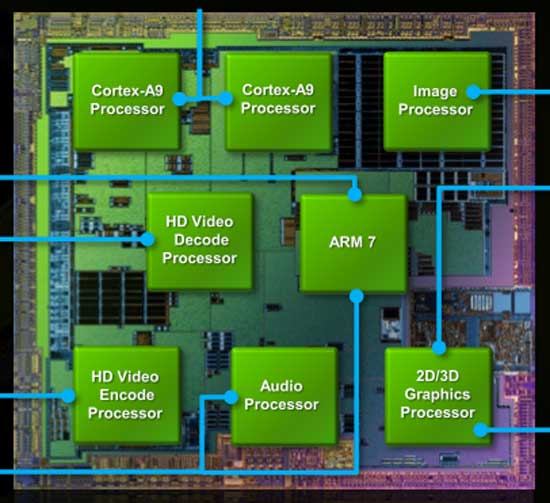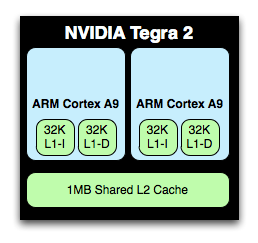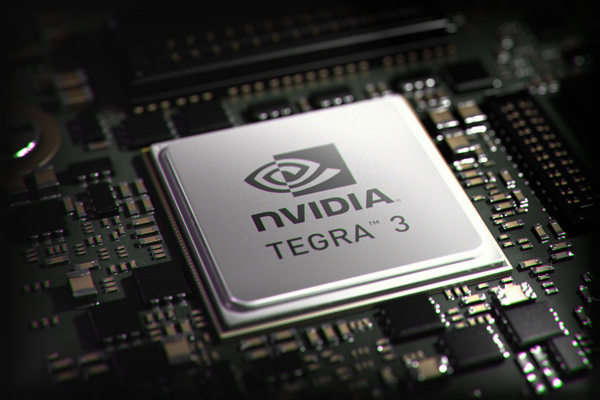NVIDIA's Tegra 3 Launched: Architecture Revealed
by Anand Lal Shimpi on November 9, 2011 12:34 AM ESTOriginally announced in February of this year at MWC, NVIDIA is finally officially launching its next-generation SoC. Previously known under the code name Kal-El, the official name is Tegra 3 and we'll see it in at least one product before the end of the year.
Like Tegra 2 before it, NVIDIA's Tegra 3 is an SoC aimed at both smartphones and tablets built on TSMC's 40nm LPG process. Die size has almost doubled from 49mm^2 to somewhere in the 80mm^2 range.
The Tegra 3 design is unique in the industry as it is the first to implement four ARM Cortex A9s onto a chip aimed at the bulk of the high end Android market. NVIDIA's competitors have focused on ramping up the performance of their dual-core solutions either through higher clocks (Samsung Exynos) or through higher performing microarchitectures (Qualcomm Krait, ARM Cortex A15). While other companies have announced quad-core ARM based solutions, Tegra 3 will likely be the first (and only) to ship in an Android tablet and smartphone in 2011 - 2012.

NVIDIA will eventually focus on improving per-core performance with subsequent iterations of the Tegra family (perhaps starting with Wayne in 2013), but until then Tegra 3 attempts to increase performance by exploiting thread level parallelism in Android.
GPU performance also sees a boon thanks to a larger and more efficient GPU in Tegra 3, but first let's talk about the CPU.
Tegra 3's Four Five Cores
The Cortex A9 implementation in Tegra 3 is an improvement over Tegra 2; each core now includes full NEON support via an ARM MPE (Media Processing Engine). Tegra 2 lacked any support for NEON instructions in order to keep die size small.

NVIDIA's Tegra 2 die

NVIDIA's Tegra 3 die, A9 cores highlighted in yellow
L1 and L2 cache sizes remain unchanged. Each core has a 32KB/32KB L1 and all four share a 1MB L2 cache. Doubling core count over Tegra 2 without a corresponding increase in L2 cache size is a bit troubling, but it does indicate that NVIDIA doesn't expect the majority of use cases to saturate all four cores. L2 cache latency is 2 cycles faster on Tegra 3 than 2, while L1 cache latencies haven't changed. NVIDIA isn't commenting on L2 frequencies at this point.


The A9s in Tegra 3 can run at a higher max frequency than those in Tegra 2. With 1 core active, the max clock is 1.4GHz (up from 1.0GHz in the original Tegra 2 SoC). With more than one core active however the max clock is 1.3GHz. Each core can be power gated in Tegra 3, which wasn't the case in Tegra 2. This should allow for lightly threaded workloads to execute on Tegra 3 in the same power envelope as Tegra 2. It's only in those applications that fully utilize more than two cores that you'll see Tegra 3 drawing more power than its predecessor.
The increase in clock speed and the integration of MPE should improve performance a bit over Tegra 2 based designs, but obviously the real hope for performance improvement comes from using four of Tegra 3's cores. Android is already well threaded so we should see gains in portions of things like web page rendering.
It's an interesting situation that NVIDIA finds itself in. Tegra 3 will show its biggest performance advantage in applications that can utilize all four cores, yet it will be most power efficient in applications that use as few cores as possible.
There's of course a fifth Cortex A9 on Tegra 3, limited to a maximum clock speed of 500MHz and built using LP transistors like the rest of the chip (and unlike the four-core A9 cluster). NVIDIA intends for this companion core to be used for the processing of background tasks, for example when your phone is locked and in your pocket. In light use cases where the companion core is active, the four high performance A9s will be power gated and overall power consumption should be tangibly lower than Tegra 2.
Despite Tegra 3 featuring a total of five Cortex A9 cores, only four can be active at one time. Furthermore, the companion core cannot be active alongside any of the high performance A9s. Either the companion core is enabled and the quad-core cluster disabled or the opposite.
NVIDIA handles all of the core juggling through its own firmware. Depending on the level of performance Android requests, NVIDIA will either enable the companion core or one or more of the four remaining A9s. The transition should be seamless to the OS and as all of the cores are equally capable, any apps you're running shouldn't know the difference between them.











94 Comments
View All Comments
Lucian Armasu - Wednesday, November 9, 2011 - link
Those probably use more power, too, so they wouldn't be suited for tablets and smartphones anyway. Tegra 3 is the first quad core to be optimized for them.jeremyshaw - Wednesday, December 21, 2011 - link
about as relevent as claiming the iPad 2 GPU doesn't matter since it doesn't use Android.jeremyshaw - Friday, December 16, 2011 - link
PS Vita is going on sale this Sat in Japan. For the rest of the world.... sucks to be you :pDraiko - Wednesday, November 9, 2011 - link
With a 3-5 hour battery life per charge. Disgusting.Shadowmaster625 - Wednesday, November 9, 2011 - link
Probably only 1 hour playing a game using the unreal engine or similar.tipoo - Wednesday, November 16, 2011 - link
They said 3-5 hours of gameplay on the Vita, other stuff is more.tipoo - Saturday, March 10, 2012 - link
Which is also what you get while gaming on any smartphone, if not less by the way.GeekBrains - Wednesday, November 9, 2011 - link
Let's wait and see how it affects the real world bandwidth requirements..dagamer34 - Wednesday, November 9, 2011 - link
Seems there's also a "lot of concern" too over the unchanged aspects of the Tegra 3 chip. They're shoving this entire design onto a 40nm process where every other competitor is focusing on 28nm which means greater power consumption at some point. Also, when you compare the numbers on the GPU, it seems that nVidia's got a rather weak offering comparing to the competition, which is kind of sad for a GPU company. What gives?B3an - Wednesday, November 9, 2011 - link
It's because of 40nm, with any more GPU power the chip would be even bigger. It's looking like there will be a 28nm version of Tegra 3 next year, but in order to be the first out with a quadcore SoC they have decided to use 40nm for now.